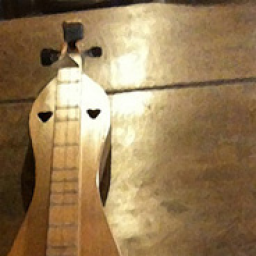You might begin by applying a clamp to the tailpiece and drawing it down to where it almost touches the bottom of the tailblock. The easing a folded length of 100g sandpaper and clamping just enough to enable the paper to be drawn back and forth, getting some clean wood. Then you can relax the clamp, brush in some glue and re-clamp to fully join the break.
That break was likely caused by the design feature of a cut-away top along the sides of the last few inches of the fretboard, intended to increase the volume perhaps.
Further fasten that break by drilling a tapered hole for a screw long enough to engage about an inch of the bottom half of the tailblock break. Tapered screw drills can be purchased at good hardware stores. Your photos don't show any sense of the actual size of things, but a #8x1-1/2" screw might be about right.
Interesting design, otherwise! Especially the peghead. A top view of that pegbox might disclose another place where some preventive re-design would help, as it looks like the slot for the interior of the pegbox might extend right to the end of the peghead, in the view you supply!


